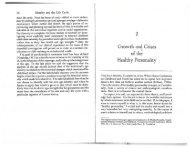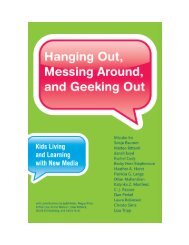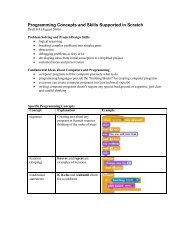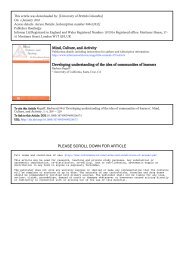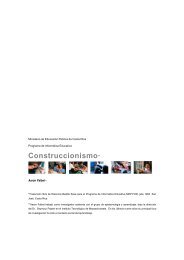Gaming Literacies: A Game Design Study in Action - MIT
Gaming Literacies: A Game Design Study in Action - MIT
Gaming Literacies: A Game Design Study in Action - MIT
Create successful ePaper yourself
Turn your PDF publications into a flip-book with our unique Google optimized e-Paper software.
<strong>Gam<strong>in</strong>g</strong> <strong>Literacies</strong>: A <strong>Game</strong> <strong>Design</strong> <strong>Study</strong> <strong>in</strong> <strong>Action</strong> 305<br />
and writ<strong>in</strong>g <strong>in</strong> terms of games as multimodal texts we are <strong>in</strong>stead explor<strong>in</strong>g<br />
game design itself as a form of procedurally-based, multimodal literacy,<br />
which allows for the read<strong>in</strong>g and writ<strong>in</strong>g of symbolic systems but does so<br />
through the qualities and characteristics of the medium itself as activated<br />
through play.<br />
<strong>Game</strong> design as a doma<strong>in</strong> of professional practice <strong>in</strong>volves a rich array<br />
of knowledge and skills. Know<strong>in</strong>g how to put together a successful game<br />
<strong>in</strong>volves system-based th<strong>in</strong>k<strong>in</strong>g, iterative critical problem solv<strong>in</strong>g, art and<br />
aesthetics, writ<strong>in</strong>g and storytell<strong>in</strong>g, <strong>in</strong>teractive design, game logic and rules,<br />
and programm<strong>in</strong>g skills. The designer must also be a socio-technical eng<strong>in</strong>eer,<br />
th<strong>in</strong>k<strong>in</strong>g about how people will <strong>in</strong>teract with the game and how the<br />
game will shape both competitive and collaborative social <strong>in</strong>teraction. <strong>Design</strong>ers<br />
must use complex technical l<strong>in</strong>guistic and symbolic elements from a<br />
variety of doma<strong>in</strong>s, at a variety of different levels, and for a variety of different<br />
purposes. They must explicate and defend design ideas, describe design<br />
issues and player <strong>in</strong>teractions at a meta-level, create and test hypotheses, and<br />
reflect on the impact of their games as a dist<strong>in</strong>ctive form of media <strong>in</strong> relation<br />
to other media. And each of these <strong>in</strong>volves a meld<strong>in</strong>g of technological, social,<br />
communicational, and artistic concerns, <strong>in</strong> the framework of a form of<br />
scientific th<strong>in</strong>k<strong>in</strong>g <strong>in</strong> the broad sense of the term (e.g., hypothesis and theory<br />
test<strong>in</strong>g, reflection and revision based on evidence, etc.). <strong>Design</strong>ers are mak<strong>in</strong>g<br />
and th<strong>in</strong>k<strong>in</strong>g about complex <strong>in</strong>teractive systems, a characteristic activity<br />
<strong>in</strong> both the media and <strong>in</strong> science today.<br />
Connected to an embodiment of practices undertaken by a game designer<br />
<strong>in</strong> the real world are the practices taken up and enacted by players, who<br />
are equal stakeholders <strong>in</strong> the <strong>Game</strong>star Mechanic experience. In the same<br />
way that reflection-<strong>in</strong>-action requires an <strong>in</strong>tegration of th<strong>in</strong>k<strong>in</strong>g and do<strong>in</strong>g,<br />
<strong>Game</strong>star Mechanic comb<strong>in</strong>es play<strong>in</strong>g with mak<strong>in</strong>g, connected activities<br />
situated <strong>in</strong> a social world. While players have the run of their own Factory,<br />
they must connect with other players <strong>in</strong> the <strong>Game</strong>star Mechanic community,<br />
both to share expertise and to play together via the games they build. Situat<strong>in</strong>g<br />
learn<strong>in</strong>g with<strong>in</strong> a community of learners is critical, as members of the<br />
New London Group (2000) wrote <strong>in</strong> regard to the concept of multiliteracies:<br />
“…if one of our pedagogical goals is a degree of mastery <strong>in</strong> practice, then<br />
immersion <strong>in</strong> a community of learners engaged <strong>in</strong> authentic versions of such<br />
practice is necessary” (p. 84). This immersion is important not only <strong>in</strong> mak<strong>in</strong>g<br />
the experience an engag<strong>in</strong>g one, but <strong>in</strong> express<strong>in</strong>g the absolute connection<br />
between k<strong>in</strong>ds of literacies and learn<strong>in</strong>g that take place <strong>in</strong> and around<br />
the play experience itself. It is the mobilization of these forms of learn<strong>in</strong>g<br />
that are at the heart of our exploration, and have led me to consider further



